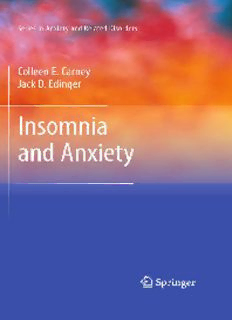
Insomnia and Anxiety PDF
Preview Insomnia and Anxiety
Insomnia and Anxiety Series in Anxiety and Related Disorders Series Editor: Martin M. Antony, Professor, Department of Psychology, Ryerson University, Toronto, Ontario, Canada For other titles published in this series, go to www.springer.com/series/6926 Colleen E. Carney Jack D. Edinger ● Insomnia and Anxiety Colleen E. Carney Jack D. Edinger Department of Psychology Department of Psychiatry and Behavioral Ryerson University Sciences Toronto ON Duke University Medical Center Canada Durham, NC [email protected] USA [email protected] ISBN 978-1-4419-1433-0 e-ISBN 978-1-4419-1434-7 DOI 10.1007/978-1-4419-1434-7 Springer New York Dordrecht Heidelberg London Library of Congress Control Number: 2010922365 © Springer Science+Business Media, LLC 2010 All rights reserved. This work may not be translated or copied in whole or in part without the written permission of the publisher (Springer Science+Business Media, LLC, 233 Spring Street, New York, NY 10013, USA), except for brief excerpts in connection with reviews or scholarly analysis. Use in connec- tion with any form of information storage and retrieval, electronic adaptation, computer software, or by similar or dissimilar methodology now known or hereafter developed is forbidden. The use in this publication of trade names, trademarks, service marks, and similar terms, even if they are not identified as such, is not to be taken as an expression of opinion as to whether or not they are subject to proprietary rights. Printed on acid-free paper Springer is part of Springer Science+Business Media (www.springer.com) For Shannon and Sydney Colleen E. Carney In loving memory of my parents who always encouraged my best efforts and to my wife Wanda who tolerated those well over the years. Jack D. Edinger v Acknowledgements We would like to thank our students for their help with this manu- script and for inspiring us to write it. vii Contents 1 Anxiety and Insomnia: An Overview ...................................................... 1 What is Insomnia? ....................................................................................... 2 Diagnostic Considerations for Insomnias ................................................... 3 The Case of Comorbid Insomnia: More Nosological Issues ...................... 4 Cognitive Behavioral Model of Insomnia and Anxiety .......................... 7 Summary ..................................................................................................... 9 References ................................................................................................... 9 2 Considerations for Assessment ................................................................ 13 Assessment of Sleep ................................................................................... 13 Actigraphic Measurement of Sleep ............................................................. 15 Subjective Assessment of Sleep .................................................................. 15 Clinical Interview ........................................................................................ 18 Self-report Measurement ............................................................................ 18 Global Sleep Symptom Questionnaires .................................................. 18 Cognitive Insomnia Questionnaires ........................................................ 19 Behavioral Insomnia Questionnaires ...................................................... 20 Daytime Insomnia Symptom Questionnaires ......................................... 20 Assessment of Anxiety ............................................................................... 21 Structured Interviews for Anxiety. .............................................................. 22 Clinician-Administered Interviews for Anxiety ..................................... 22 Clinician-Administered Interviews for Specific Anxiety Disorders ................................................................................... 22 Self-Report Measures for Anxiety Symptoms ........................................ 23 General Measures for Self-Reported Anxiety ......................................... 23 Anxiety Disorder-Specific Self-Report Questionnaires .......................... 24 Case Example 1: Generalized Anxiety Disorder and Insomnia .................. 26 Case Example 2: Sleep-Specific Worry ...................................................... 27 References ................................................................................................... 28 3 Anxiety Disorders and Accompanying Insomnia ................................... 33 Panic Disorder ............................................................................................. 33 Generalized Anxiety Disorder .................................................................... 35 ix x Contents Posttraumatic Stress Disorder: PTSD ......................................................... 37 Obsessive–Compulsive Disorder ................................................................ 40 Social Phobia .............................................................................................. 42 Specific Phobias .......................................................................................... 43 Summary ..................................................................................................... 45 References ................................................................................................... 45 4 Cognitive Behavior Therapy for Insomnia: Treatment Considerations ........................................................................ 51 What is Cognitive Behavior Therapy and Who Can Benefit from It? ........................................................................................... 51 Cognitive Behavior Therapy Model ............................................................ 53 The Evidence Supporting CBT for Insomnia ............................................. 55 Treatment Delivery Issues ........................................................................... 56 References ................................................................................................... 59 5 Medication Considerations ...................................................................... 63 Will Cognitive Behavior Insomnia Therapy Work with Those Who Use Sleep Medications? ........................................ 63 Prescription Hypnotics: Advantages and Disadvantages ............................ 65 Over-the-Counter Medications, Herbal Remedies, and Alternative Treatments ......................................................................... 66 Antihistamine-Based Sleep Aids ............................................................ 67 Herbal Compounds and Dietary Supplements ........................................ 68 Melatonin ................................................................................................ 68 Alcohol .................................................................................................... 69 Can Common Anxiety Medications Cause Insomnia Symptoms? ............. 70 Combining Sleep Medications with CBT for Insomnia ............................. 71 Sleep Medication Discontinuation Strategies ............................................. 73 References ................................................................................................... 75 6 Behavioral Strategies for Managing Insomnia ....................................... 79 Assessing the Sleep Problem Using the Sleep Diary .................................. 79 Setting the Stage for Treatment Recommendations: The Role of Psychoeducation ..................................................................... 84 Presenting Behavioral Insomnia Treatment Recommendations ................. 86 Addressing Sleep Hygiene Issues ............................................................... 89 The Value of Follow-Up Sessions ............................................................... 91 Assistance with TIB Changes ..................................................................... 92 Reviewing/Reinforcing Adherence ............................................................. 93 Trouble-Shooting Problems ........................................................................ 94 Case 1 ...................................................................................................... 95 Case 2 ...................................................................................................... 95 Case 3 ...................................................................................................... 96 References ................................................................................................... 97 Contents xi 7 Sleep-Related Cognitive Processes .......................................................... 99 Harvey’s (2002) Cognitive Model .............................................................. 99 The Role of Thoughts ................................................................................. 100 Unwanted Repetitive Mental Activity..................................................... 101 The Role of Distress .................................................................................... 102 Beliefs in Insomnia ..................................................................................... 102 Attention and the “Threat” of Sleep ............................................................ 103 The Role of Attributions ............................................................................. 104 Maintaining the Status Quo ........................................................................ 105 References ................................................................................................... 106 8 Cognitive Strategies for Managing Anxiety and Insomnia ................... 109 Worry Management Strategies .................................................................... 109 Constructive Worry Worksheet Example .................................................... 111 Cognitive Restructuring .............................................................................. 112 Thought Record .......................................................................................... 113 Decreasing Safety Behaviors and Behavioral Experiments ........................ 117 Focus on Relapse Prevention ...................................................................... 119 Action Plan for Addressing Insomnia ......................................................... 119 Red Flags for a Possible Problem with Insomnia ....................................... 120 What Tools Work for This Problem? .......................................................... 120 References ................................................................................................... 121 9 Other Issues in Managing the Sleep of Those with Anxiety .................. 123 Relaxation-Based Strategies ....................................................................... 123 PMR Treatment Outline .............................................................................. 126 Cognitive Behavioral Treatment of Nocturnal Panic .................................. 131 Craske’s Nocturnal Panic Protocol ............................................................. 131 Treating Claustrophobia Associated with Sleep Apnea Treatment ............ 134 Dream/Nightmare Rescripting .................................................................... 138 Is it Time for a Sleep Specialist Consultation? ........................................... 143 References ................................................................................................... 145 Index ................................................................................................................. 149
Description: